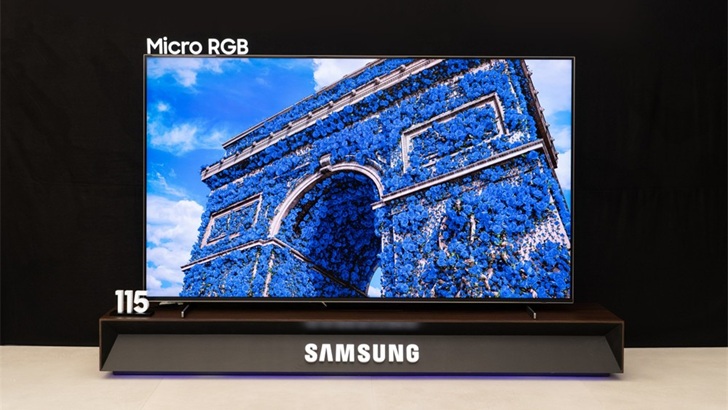Is Samsung's New Micro RGB Technology the Future of Premium TVs?

Revolutionizing Display Technology: The Impact of Micro RGB Technology
In a world where visual technology continuously evolves, Samsung Electronics has taken a monumental leap with the introduction of Micro RGB displays. With sub-100-micrometer LEDs, this groundbreaking technology redefines what we know about premium display standards. The Micro RGB not only promises exceptional color accuracy but also sets the stage for a new era in display innovation.
The Science Behind Micro RGB Technology
At the core of Micro RGB is a pioneering approach to micro-scale LED technology. Unlike traditional LED displays, which utilize larger diodes, Micro RGB employs tiny LEDs that are less than 100 micrometers in size. This miniaturization allows for more LEDs to fit within the same screen area, resulting in a significantly enhanced pixel density. The result? Sharper images, richer colors, and improved overall performance.
Exceptional Color Accuracy
One of the standout features of Micro RGB technology is its ability to deliver unparalleled color accuracy. By utilizing smaller LEDs, each pixel on the display can produce a wider range of colors. This means that viewers can experience true-to-life images that are vibrant and detailed. Whether you're watching a movie, playing a video game, or working on graphic design, the accuracy of colors can make a substantial difference in your viewing experience.
Enhanced Brightness and Contrast
Micro RGB technology also brings significant enhancements in brightness and contrast levels. The compact size of the LEDs allows for better control over light emission, enabling the display to achieve higher brightness levels without compromising energy efficiency. This adaptability ensures that colors remain vivid, even in brightly lit environments, making it ideal for various applications, from home theaters to commercial displays.
Applications of Micro RGB Technology
The versatility of Micro RGB technology opens up numerous possibilities across different sectors:
- Consumer Electronics: Televisions and monitors equipped with Micro RGB can provide viewers with an immersive experience that was previously unattainable.
- Commercial Displays: Retail environments can utilize Micro RGB to create eye-catching advertisements that attract customer attention.
- Automotive Displays: As vehicles increasingly incorporate advanced display technologies, Micro RGB can improve dashboard and infotainment systems.
- Medical Imaging: Enhanced color accuracy can aid in diagnostics and medical imaging, where precision is critical.
Durability and Longevity
Another significant advantage of Micro RGB technology is its durability. Micro LEDs are known for their longevity compared to traditional OLED and LCD screens. They are less susceptible to burn-in issues and degradation over time, which means users can enjoy their displays without worrying about diminished performance. This makes Micro RGB an attractive option for both consumers and businesses looking for long-term solutions.
Energy Efficiency
In a time when sustainability is paramount, Micro RGB technology stands out for its energy efficiency. The smaller size of the LEDs allows for lower power consumption while maintaining high brightness levels. This can result in significant energy savings, especially in large installations or displays that are in use for extended periods. As consumers become more environmentally conscious, this aspect of Micro RGB technology is likely to resonate strongly.
The Competitive Landscape
As Samsung launches its Micro RGB displays, it enters a competitive landscape filled with established players in the display technology market. Companies like LG, Sony, and others are also innovating in this space, creating pressure to continuously enhance their offerings. However, Samsung's lead in Micro RGB technology positions it well for capturing market share in the ultra-premium segment, particularly among discerning consumers and businesses.
Future Prospects of Micro RGB Technology
The introduction of Micro RGB technology is just the beginning. As research and development in micro-scale LEDs continue to advance, we can expect even more enhancements in display capabilities. Future iterations may include even smaller LED sizes, improved manufacturing processes, and integration with AR/VR technologies, further expanding the horizons of what is possible in visual displays.
Potential Challenges Ahead
Despite its promise, Micro RGB technology is not without challenges. The manufacturing process for micro-scale LEDs is complex and may face scalability issues as demand increases. Additionally, the cost of production remains a concern, as high-quality displays often come with a premium price tag. Samsung and other manufacturers must navigate these challenges to make Micro RGB technology accessible to a broader audience.
Conclusion: The Future of Premium Displays
Samsung's Micro RGB technology heralds a new era in display excellence, delivering exceptional color accuracy, enhanced brightness, and energy efficiency. Its applications across various sectors demonstrate its versatility and potential to reshape how we interact with screens. As the landscape of display technology continues to evolve, Micro RGB stands at the forefront, promising a future where visuals are not just seen, but experienced. The question now is: how will this technology influence your viewing habits and experiences in the coming years?
FAQs
What is Micro RGB technology?
Micro RGB technology refers to the use of micro-scale LEDs, which are less than 100 micrometers in size, to create displays with exceptional color accuracy and brightness. This technology allows for a higher pixel density and improved visual performance.
How does Micro RGB compare to traditional LED displays?
Micro RGB displays outperform traditional LED displays by offering a higher color accuracy, better brightness levels, and improved energy efficiency due to the smaller size of the LEDs, which allows for greater control over light emission.
What are the applications of Micro RGB technology?
Micro RGB technology can be applied across various sectors, including consumer electronics (TVs and monitors), commercial displays (advertisements), automotive displays (dashboard systems), and medical imaging (diagnostics).
Is Micro RGB technology energy efficient?
Yes, Micro RGB technology is known for its energy efficiency, as the smaller LEDs consume less power while maintaining high brightness levels, leading to significant energy savings.
What challenges does Micro RGB technology face?
Some challenges include the complexity of the manufacturing process, scalability issues, and the potential high cost of production, which may limit accessibility for some consumers.
As we look to the future, how do you envision Micro RGB technology changing the way we experience visual content? #MicroRGB #DisplayTechnology #Innovation
Published: 2025-08-12 02:02:28 | Category: Uncategorized



